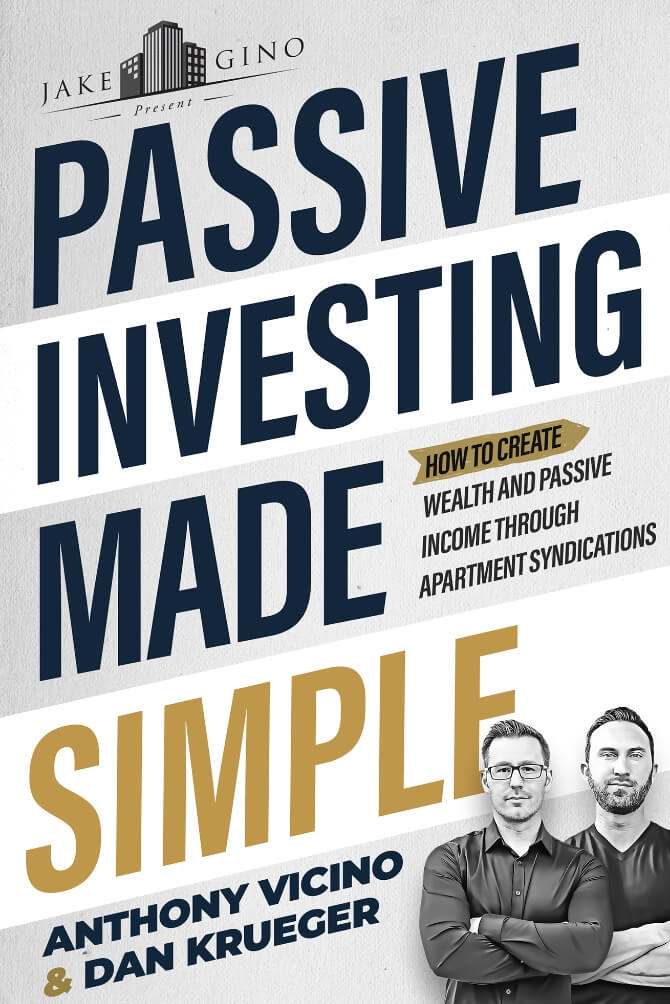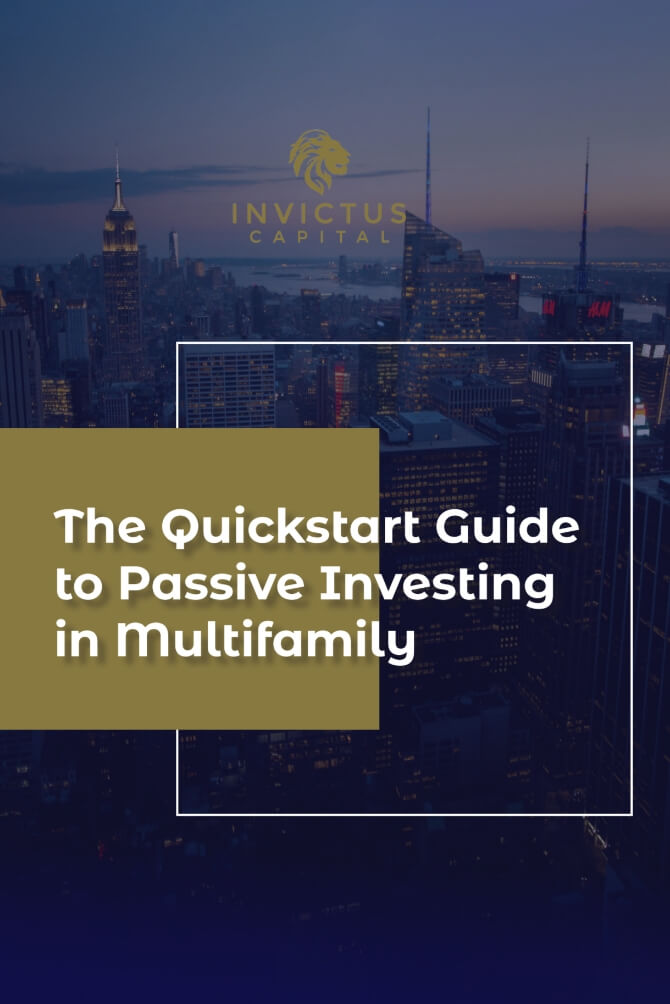“If you’re flying too close to the sun and you don’t have a safety net, your wings are probably gonna melt.” – Anthony Vicino
What does it mean for a property to be physically and economically vacant?
Are they the same thing? Physical vacancy refers to a vacant unit with no person leasing it.
Economic vacancy is quite different. It’s sometimes used synonymously with a specific term.
What do you think is that term? We will talk about that and more on the concept of vacancy in another episode of Multifamily Investing Made Simple in Under 10 minutes.
Tweetable Quotes:
“Having a body in the unit doesn’t necessarily mean that that person is actually paying their rents.” – Dan Krueger
LEAVE A REVIEW if you liked this episode!!
Keep up with the podcast! Follow us on Apple, Stitcher, Google, and other podcast streaming platforms.
To learn more, visit us at: https://invictusmultifamily.com
**Want to learn more about investing with us?**
We’d love to learn more about you and your investment goals. Please fill out this form and let’s schedule a call: https://invictusmultifamily.com/
**Let’s Connect On Social Media!**
LinkedIn: https://www.linkedin.com/company/11681388/admin/
Facebook: https://www.facebook.com/invictuscapitalventures/
YouTube: https://bit.ly/2Lc0ctX
Vacancy Made Simple:
ANTHONY VICINO (00:00):
Hey and welcome to multifamily investing made simple in under 10 minutes. I’m your host, Anthony Vicino of Invictus capital joined as always by my partner, DAN KRUEGER. Today we’re going to be simplifying the concept of vacancy in under 10 minutes, we’re going to be talking economic vacancy and physical vacancy. What it is, why is it important? And without further delay, let’s get into it. Dan, take it away. What is physical vacancy? What are we referring to there?
DAN KRUEGER (00:43):
That is an open unit. So if you’ve ever driven by a motel, I don’t know if they do the same more, but they usually have a little thing that says vacancy. Yes or no or something. That’s maybe that’s just movies from the nineties. I don’t know. But a physical vacancy is a vacant unit, meaning there’s no person in there leasing it. You might have a squatter. I don’t know, but there’s no one leasing. The unit economic vacancy is a different thing because sometimes you can have, and this is very important. If you’re out there looking for properties, having a body in a unit doesn’t necessarily mean that that person is actually paying their rent. So economic vacancy as sometimes used kind of synonymously with the term collections. So if someone asks, you know, what are your collections like? That’s pretty much the same question as saying, what’s your economic vacancy. If any, like if you’ve got 10 units at, in a 10 unit building, each one is leased up for a thousand dollars a month. Are you actually getting a thousand bucks a month from each person, or is one guy only giving you a 950 or 900 and accruing a passive balance? So that in a nutshell is what physical and economic vacancy slash collections is referring to
ANTHONY VICINO (01:54):
Economic vacancy to split that into like a slightly different term. It refers to the proportion of the gross potential income that’s collected. So if we have 10 units in each one’s renting out at a thousand dollars, then the gross potential income of that property is $10,000. If we’re only collecting $9,000 per month, let’s say one unit just isn’t paying, or let’s say a couple of units or they’re behind. And they’ve only paid a portion for whatever reason. We’re only getting $9,000 of that $10,000 GPI gross potential income. And so that means our economic vacancy is 90%. We’re only collecting 90% of the total. That’s going to be different than the physical vacancy. So in the same example, we have just 10 units filled up.
DAN KRUEGER (02:39):
Just for the sake of action. I think that would actually, your economic occupancy would be 90% and your economic vacancy would be 10%.
ANTHONY VICINO (02:47):
Oh, I’m drunk over here. People, what do you want?
DAN KRUEGER (02:49):
Is right? But it was just inverted a little bit
ANTHONY VICINO (02:52):
Yeah here are the words, economic occupancy, and economic vacancy. I inverted those two and not instant. So to compare that against physical vacancy, if we have those same 10 units and all 10 are filled, then we’re a hundred percent physically occupied. Awesome. Maybe if maybe two of those are vacant, then we’re only at 80% occupied or 20% vacant that I get it right that time.
DAN KRUEGER (03:11):
Yes. And I think this part is, you know, important for investors to ask the operators about, because this probably isn’t going to be something that’s glaringly obvious in a deal package or an offering memorandum. Usually people are going to look at vacancy in a very simplistic way and say, okay, how many, how many units are leased up? Are there any units that are unleased? But a really important question is, especially if you’re looking at value, add deals that are in gentrifying neighbourhoods, or if you’re getting a product from kind of like a mom and pop operation, something that isn’t uncommon is smaller, poor operators. If they want to sell a building, it’s not uncommon for them to start shoving people in there to fill up the units so that they look like they’re a hundred percent occupied. The way to get around this is to look at the T 12 or the T3 of the T6, basically the trailing a couple months or year of actual financials and bump that up against the bank statements. We can get them and see if that money’s actually showing up in the bank, because if it is then you’re fine. But if you see that, you know, that example that Anthony laid out there illustrated, here you say you’re a hundred percent occupied. We should be getting 10 grand a month consistently or only see 9,000 to 9,500 in here. You know, so we’ve got some economic vacancy that is hiding in there. So it’s a sneaky little thing.
ANTHONY VICINO (04:32):
Another term that I want to throw in here in the 11th hour, which is also pretty helpful to understand is the breakeven occupancy. And it kind of ties in because the breakeven occupancy tells us what the minimum occupancy rate is required to cover all of a property’s expenses. So let’s say our break even occupancy is in that service. Well, when we talk about property expenses, yeah, that’s a, we’re talking holistically, every everything, the whole shebang, all of our outgoing, outflows, that’s an important one because honestly the debt’s going to be the biggest portion of contributing to the breakeven occupancy
DAN KRUEGER (05:05):
And debt service to just, yeah, they want their money.
ANTHONY VICINO (05:08):
But the breakeven occupancy let’s say on a deal is say 70%. That means you could afford to only collect 70% of the GPI, the gross potential income. And you would still be making enough to cover all the monthly expenses. Just dip below that. No good. Go above that. Great. Now you’re making money. Yeah.
DAN KRUEGER (05:27):
So you’re not just looking at your capex. So just want to clarify that
ANTHONY VICINO (05:32):
Understanding that breakeven occupancy compared against economic vacancy. So sometimes those numbers get a little bit closer than feels good.
DAN KRUEGER (05:40):
I probably notice that quite a bit. When you’re looking at newer A-class properties, very high dollar properties, those typically have to be pretty full. So, you know, this is a good one to, to ask about, I’d say maybe half the time you might see that this data, that the breakeven occupancy actually in a deal package or offering memorandum. So if it’s not in there ask because it’s a very, it can be a very telling metric because you get to find out exactly how much wiggle room these operators have. Their break even occupancy is at 90%. Then there’s not a lot of room for something to go wrong or any unexpected things like I don’t know COVID or something like that. Someone with that kind of breakeven is not going to weather any storm very well.
ANTHONY VICINO (06:27):
I’m going to propose, we officially rename the breakeven occupancy to the wiggle room rate. It just tells you how much wiggle room, all right, how much wiggle room you have on the deal. And that could be very, very helpful because if you’re flying too close to the sun and you don’t have a safety net, your wings are probably going to melt and the end result is going to be catastrophic. So interesting analogy. Yeah. I don’t know where I was going with that, but Hey, look at that. We have simplified the physical and economic vacancy and a bonus breakeven occupancy. And under 10 minutes, if that isn’t worthy of a five-star review over on iTunes or Spotify or wherever, you’re listening to this dear listener that I don’t know what you need from us. Maybe go leave a review and tell us what you need from us. I’m impressed. All right. All right. So before you asked you leave, please, please, please do us a favour actually, to go to the review and we’d really appreciate that. And we’ll catch you next week.



